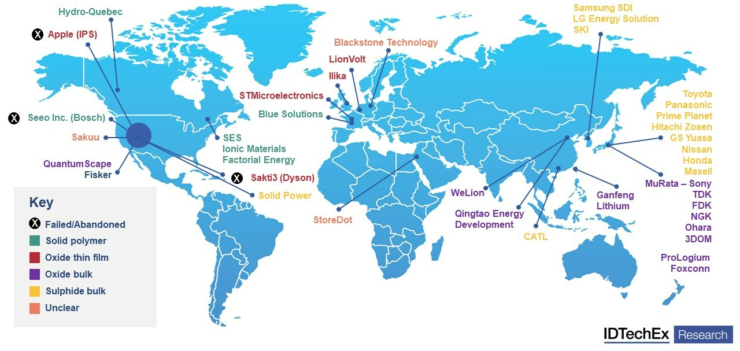IDTechEx discusses hypes and hopes of solid-state batteries.
The rapid growth of the electric vehicle market has driven the development, manufacture and sales of batteries, especially lithium-ion batteries, which are dominating the battery industry for a decade. However, due to the performance limitation, environmental protection and supply chain considerations, next-generation energy storage technologies are being R&D all the time.
Among all the options, the popular discussions on solid-state batteries have brought efforts both in academia and industry. Solid-state batteries have attracted the most attention from research institutes, material providers, battery vendors, component suppliers, automotive OEMs, venture capitals, and investors. There are also an increasing number of players working on solid-state batteries globally.
Global major solid-state battery players. Source: IDTechEx – “Solid-State and Polymer Batteries 2023-2033: Technology, Forecasts, Players“
🔥 What about we co-host a webinar? Let's educate, captivate, and convert the battery economy!
Batteries News is the global go-to online magazine for the battery industry, we can help you host impactful webinars that become a global reference on your topic and are an evergreen source of leads. Click here to request more details
What Can Solid-State Batteries Bring In Reality
Solid-state batteries are considered the “holy grail” as they are believed to have many advantages. These advantages include better safety, higher energy density, longer cycle life, more durability, wider operating temperature range, close stacking, simplified battery design, possible flexible mechanical feature, and much more.
For instance, solid-state batteries replace organic liquid electrolytes with solid-state counterparts, enabling safer, long-lasting batteries. In addition, solid-state electrolyte can be compatible with high voltage-cathode materials and high-capacity lithium metal anode. It is possible to push the energy density beyond 1,000 Wh/L.
However, most solid-state electrolytes have a higher density than the polyolefin separator, especially the inorganic solid-state electrolyte. And they are typically thicker than separators used in conventional lithium-ion batteries. If the electrodes are kept the same (still graphite anode and layered metal oxide cathode), most solid-state batteries end up with lower gravimetric energy density compared with lithium-ion batteries.
In addition, many people mentioned that the thermal management system can be removed for solid-state batteries because they are safe. Nevertheless, this is not true. Solid-state batteries may have a different safe operation area compared to lithium-ion batteries. Thermal management systems and many other protections are still necessary.
Then another voice is that solid-state batteries will not have a chance as their value propositions are unrealistic or too difficult to achieve.
The optimistic and pessimistic opinions indicate a lack of understanding of solid-state batteries. As the solid-state battery industry is still immature, depending on which technology we are talking about, they have different value propositions, cell designs, performance, supply chain requirements, manufacturing methods and readiness levels. But generally speaking, better safety, potentially higher energy density and simplified system designs are still the major drivers of solid-state batteries.
Three Major Material Systems
Within the solid-state battery regime, there are various technology approaches. Oxide, sulfide and polymer systems have become the most popular options in the next-generation development, with further variations under each category. In general, sulfide electrolytes have the advantages of high ionic conductivity, even better than liquid electrolyte, low processing temperature, wide electrochemical stability window, etc.
Many features make them appealing, being considered by many as the ultimate option. However, the difficulty of manufacturing and the toxic by-product hydrogen sulfide generated in the process make the commercialization relatively slow. Polymer systems are easy to fabricate, most compatible with existing manufacturing facilities, and some are already commercialized.
While the relatively high operating temperature, low anti-oxide potential and worse stability indicate challenges. Oxide systems are more stable than lithium metal, with good electrochemical and thermal stabilities. However, the higher interface resistance and higher-cost, lower-yield manufacturing processes show some difficulties in general.
There Are More We Need to Understand Better
No technology is perfect, and the complication of technical details, testing conditions and data selected to be published can confuse the public regarding the pros and cons of each technology. Therefore, this report aims to offer a detailed explanation and analysis from a technical angle, with our own opinions.
The hypes and hopes of solid-state batteries are assessed as well. Although a few advantages cannot be provided by current solid-state batteries, compared with conventional lithium-ion batteries, better safety, potential energy density increase, and system level design simplification are still the major drivers of solid-state batteries.
IDTechEx has been tracking the development of solid-state batteries since 2014, and with years of experience, we have observed the gradual transition of efforts in this industry. For instance, early focuses were mostly on solid-state electrolyte and half/full cell demonstration. With further improvement, more things are considered for commercialization. Sample validation, system design, supply chain establishment and manufacturing optimization are becoming increasingly important.
Report Coverage
The IDTechEx report, “Solid-State and Polymer Batteries 2023-2033: Technology, Forecasts, Players“, covers the solid-state electrolyte industry by giving a ten-year forecast till 2033 in terms of capacity production and market size. A special focus is made on various technologies and battery performance.
Additionally, the report covers the manufacturing challenges related to solid electrolytes and how large companies try to address those limitations, as well as research progress and activities of important players.
There are many questions around solid-state batteries, from technology benchmarking & analysis, market estimation & forecast, player activity tracking & evaluation, to supply chain establishment & security. It is important to understand both the science and business behind it to make the correct strategic decisions. IDTechEx’s latest report, “Solid-State and Polymer Batteries 2023-2033: Technology, Forecasts, Players“, answers the major questions and discusses the challenges and opportunities of solid-state batteries.
About IDTechEx
IDTechEx guides your strategic business decisions through its Research, Subscription and Consultancy products, helping you profit from emerging technologies. For more information, contact research@IDTechEx.com or visit www.IDTechEx.com.
READ the latest Batteries News shaping the battery market
IDTechEx Discusses Hypes and Hopes of Solid-State Batteries, Boston, February 6, 2023








